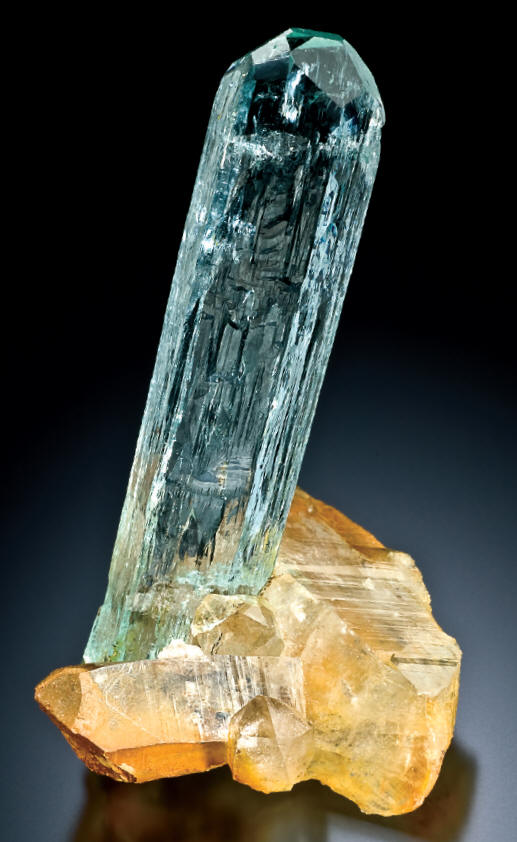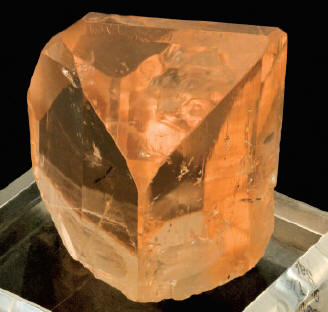
Deep blue beryl (var. aquamarine) crystal from Sakangyi, 10 cm high. N. Luppescu collelction and photo.
Cassiterite
Cassiterite rarely forms well developedcrystals, but some of these reach 5cm. They are typically black withmedium metallic luster.
Feldspar group
Minerals of the feldspar group arethe most common and constitute most ofthe volume of the pegmatite bodies. All pockets contain these crystals, and theycover most of the pocket walls.

Topaz crystal from Sakangyi, 9 cm high. M. Weill collection. FMI-J. Elliott photo.
The lack of detailed mineralogicalanalyses makes it impossible todefinitely name feldspar species. Clearly,both K-feldspars and albites are common.
K-feldspars (microcline and orthoclase)are very frequent and sometimesform crystals measuring to a few dozencentimeters. They are usually well developed,blocky, with medium luster, andwhite, gray or beige in color. Microclineoccurs sometimes as amazonite in colorsvarying through light green, blue-greenand deep green. Usually the amazonitecolor is not homogenous in the wholecrystal but intergrown with other colors.
Also, the pinkish opalescent variety of Kfeldspar(moonstone) is known fromSakangyi.
Albite is usually white and occurs asthe cleavelandite habit overgrowingolder K-feldspars. Rosettes of cleavelanditereach up to 30 cm.
Fluorite
Fluorite is an uncommon species inthe Sakangyi pegmatites. When it doesoccur it is purple-blue. Its interestingbotryoidal forms reach up to a few cm.
Herderite
A few specimens of herderite crystalson feldspar are known fromSakangyi. The biggest crystals reach upto a few cm and are green or greenish.
Mica group
Mica (most probably muscovite) isvery common in pockets in pegmatites inSakangakyi. It occurs as typical hexagonalbooklets, usually grayish or colorlesswith good translucency, and sometimeswith good luster. The size of the bookletsreaches over 20 cm, and the crystals areoften well formed and sharp-edged.
Because of the low value of mica,miners do not care too much about itsspecimens unless they are part of thematrix of specimens of the more valuablespecies.
Topaz
Topaz is the most important gemstoneand the main target of mining in Sakangyi. It is also the most significantmineral for collectors. The large size ofsome of the crystals and their sharpforms, gemminess, and interesting paragenesismake those topazes world-classspecimens.

Gem beryl (var. aquamarine) with quartz from Sakangyi, 7.5 cm high. W. Larson collection.J. Scovil photo.
The size of the crystals variesfrom a few mm up to monsters weighing80 kg! Even the biggest ones are usuallywell formed and often of cutting quality.
The majority of the topaz crystalsare colorless, white, pale orange orpale champagne-colored, but smoky,brown, light blue, deep orange and deepchampagne-colored crystals are alsoknown.
The luster of the crystals is usuallygood or very good.
The habit of the topaz crystals isclassic for this species – long to shortprismatic, and frequently stubby whencleaved. The dominant forms are prisms,rhombic pyramids and pinacoids. Crystalsfrequently exhibit a large number ofdifferent forms, making beautifully complexspecimens.
Some of the crystals have smalletching figures and growth features, especiallyon the terminations.
All of the crystals that are not wellformed are cut. The sizes of the gemstonesmade of Sakangyi topazes areexceptional, reaching thousands ofcarats!
Tourmaline groupTourmaline crystals are quite commonin Sakangyi pegmatites. Probablythese are elbaites. They are formed asprismatic crystals, usually with simplepinacoid and/or pyramid terminations.
The size of the crystals seldom exceeds2-3 cm. The majority of the crystals areeither completely black or black in theirlower parts with color-zoned, gemmy terminations.
Usually non-black tourmalinesare greenish, pink, colorless orbrown.

Gem topaz crystal from Sakangyi. W. Larson collection. M. Dixon photo.
Because the gemmy parts of tourmalinesare small they do not have highvalue as gems, but their occurrencemakes the paragenesis much more interestingand valuable for collectors.






 YueGongAnBei 44051102000467
YueGongAnBei 44051102000467


 |
|